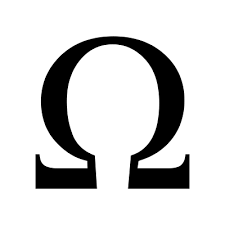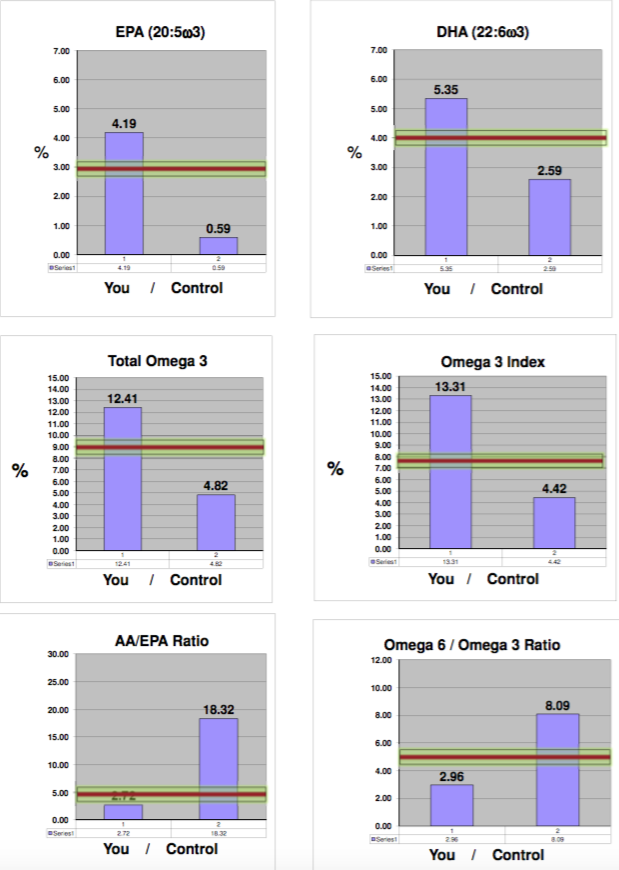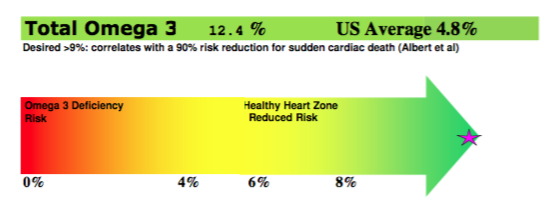
If you’ve been reading for a while, you know I harp on inflammation a lot. I’ve mentioned inflammation coming from the immune system, your belly fat, and even your liver. Another source of inflammation that can cause your body to keep cycling in protection mode and away from growth and recovery are your levels and ratios of Omega fats.
We have all heard of Omega 3 being good for us. You will see commercials advertising Omega 3 supplements and I’m seeing more and more, medicine-first minded MDs even telling their patients to start taking fish oil.
Why are Omega 3 fats so good for you? Omega 3 fats are extremely important in the structure and function of every cell in the body. The function of your cells is what determines your health. Your cells are what determines your immune function, healing, hormone levels, heart function, cholesterol levels, blood pressure, digestion, moods etc. Literally, the function and health of your cells determines every aspect of your health.
 Think of Omega 3s like your bouncer at your favorite club (your cell membrane). You want strong bouncers to keep the riff raff out of the club. If I showed up to be your bouncer, you would laugh, push me to the side, and the club would be in shambles. All hell would break loose and the club owner would have to spend a lot of time and money to repair all the damage (inflammation) that could have been prevented with bigger, stronger bouncers.
Think of Omega 3s like your bouncer at your favorite club (your cell membrane). You want strong bouncers to keep the riff raff out of the club. If I showed up to be your bouncer, you would laugh, push me to the side, and the club would be in shambles. All hell would break loose and the club owner would have to spend a lot of time and money to repair all the damage (inflammation) that could have been prevented with bigger, stronger bouncers.
One of the problems is that when people jump on the Omega 3 bandwagon, they supplement with either an inferior type or not enough of the good type.
Club Troubles
Me being a bouncer at your club would be the inferior type of Omega 3. Most often, this comes in the form of flax seed or vegetable based omega 3s. There’s nothing wrong with them. They provide a type of omega 3 (Alpha-Linolenic Acid) but what the body requires and craves the most are omega 3s in the form of EPA (Eicosapentaenoic acid) and DHA (docosahexaenoic acid). EPA and DHA would be the 6’6″, 245 lbs bouncer that is also a blackbelt in all martial arts, a trained sniper, and expert hostage negotiator.
I could try and train to become those things and pack on the mass but it will be a lengthy process, not serve your immediate needs, and most likely not serve your long term needs. In other words, the body has the capability of converting ALA to EPA and DHA. The problem is that even though the body can do those things, there’s a limitation to the amount of how much EPA and DHA can be produced just from an ALA source alone.
The conversion efficiency of ALA to EPA varies between 0.2% and 21%, and that of ALA to DHA varies between 0% and 9% (Andrew et al. 2006; Williams and Burdge 2006). You can hire me to be your bouncer and train to be the blackbelt, sniper, and negotiator but at best I would only be 21% as effective as you were hoping me to be.
If you’ve never had a bouncer before and I came along to help out, you may notice some benefit. This is often seen with people that are extremely deficient in omega 3s. They start adding vegetable sources like flax and even a little bit of EPA and DHA and see some great benefits. But again, for best long term results, you want to hire the trained bouncers. This is why I would choose EPA:DHA Omega 3 fats over ALA Omega 3 fats for supplementing. This is also why 1-2 capsules of EPA:DHA fish oil doesn’t cut it long term.
Being deficient in EPA:DHA Omega 3 can be a source of inflammation for the sole fact that your cells are not protected and you do not have enough building blocks to regenerate and repair. EPA:DHA Omega 3 fats also have an anti-inflammatory role in the body, while ALA Omega 3 doesn’t exert this same effect.
The larger issue isn’t just that most people are deficient in Omega 3. The bigger damage occurs because they are toxic in Omega 6 fats. We do need Omega 6 fats, it’s just we don’t need as much as the typical American is consuming. Whereas EPA:DHA Omega 3s have anti-inflammatory properties, ALA Omega 3 doesn’t influence inflammation, Omega 6 fats have pro-inflammatory effects.
Your biggest sources of Omega 6 fats come in the form of vegetable and seed oils like soy, cotton, corn, canola, and peanut. It’s also not just the consumption of these oils but the fact that most of these oils are then used under high heat, destroying the structure and causing you to consume rancid poison (trans fats). The more poison consumed, the more inflammation ensues. You’ll find these oils in pretty much anything in a box at the grocery store and any baked goods.
Inflammation isn’t necessarily a bad thing. Inflammation helps you repair and recover. It’s when that short term repair mechanism is fed to create a chronic response. Our industrialized world has enough insults to our body (sitting, worry, chemicals, Facebook comparisons) that most people have an inflammatory baseline fire hose constantly putting out fires. When you add the standard western diet into the mix, this sky rockets that inflammatory response.
What most Americans are left with is a ration of Omega 6 to Omega 3 totally whacked out, causing major internal struggles in the body. When you look at industrialized nation’s chronic illness rates compared to those non-industrial or hunter-gatherer populations, there’s a major difference in their ratios of Omega 3 and Omega 6.
According to Dr. Stephan Guyenet
Hunter-gatherers and healthy non-industrial cultures didn’t know what omega-6 (n-6) and omega-3 (n-3) fats were. They didn’t balance nutrients precisely; they stayed healthy by eating foods that they knew were available and nourishing. Therefore, I don’t think it’s necessary to bean count omega fats, and I don’t think there’s likely to be a single ideal ratio of n-6 to n-3. However, I do think there’s evidence for an optimal range. To find out what it is, let’s look at what’s been done by healthy cultures in the past:
- Hunter-gatherers living mostly on land animals: 2:1 to 4:1
- Pacific islanders getting most of their fat from coconut and fish: 1:2
- Inuit and other Pacific coast Americans: 1:4 or less
- Dairy-based cultures: 1:1 to 2:1
- Cultures eating fish and grains: 1:2 or less
It looks like a healthy ratio is between 4:1 and 1:4 n-6 to n-3.
Depending on where you look, many societies today, with the highest rates of chronic illness (not just heart disease), have ratios of Omega 6 to Omega 3 as high as 20:1.
Your Omega Omen
Because sufficient levels of EPA:DHA Omega 3s as well as proper rations of Omega 6 to Omega 3 are essential for maintaining the integrity of your cells, any deficiency or major imbalance can have health effects linked with cancer, heart disease, stroke, diabetes, depression as well as the autoimmune and atopic diseases such as arthritis, Crohn’s Disease, irritable bowel, psoriasis, eczema, allergies, fibromyalgia, lupus, multiple sclerosis, in addition to dysmenorrhea (menstrual pain and/or cramping), headaches, and even back and neck pain.
Your total omegas and omega rations aren’t the only factors that lead to these ailments but you can use your omegas as an omen to future health or sickness outcomes.
The bottom line solution is to consume a lot of EPA:DHA Omega 3 fats and very little Omega 6 fats. The mystery is how much? I will have people say they consume a lot of fish. I have others that say they have freezers stocked full of wild game meat. And I have many that supplement with fish oil. Is that sufficient?
It can be but what other factors are at play? A person may consume a lot of fish and wild game meat but are they combining those meals with lots of grains and dressings that contain vegetable oils? Consuming enough is one step. Balancing the ratios is another step.
Your Omega Fortune Cookie
Instead of guessing if you’re getting enough, I like to test. I use a simple home test kit called the Omega 3 test. I recently did this test and I was pleased to see I scored so well. You can see my results for yourself. AA (Arachidonic Acid) is an animal based Omega 6 fat.


How do I achieve these results? I eat a lot of fat (eggs, nuts, avocado, meats), I supplement with 8-10 capsules of fish oil daily, eat very little grains, and don’t ever cook with vegetable oils (instead using butter or coconut oil). I don’t do these things because I want to prevent a disease. I do these things because I have 5 core, personal values: God, Family, Health, Education, and Independence. In my experience personally as well as observationally, my level of health is going be the single greatest determining factor influencing my effectiveness in serving my other 4 values.
The greatest changes I see in clients long term are the ones that base their health decisions on serving their core values opposed to treating a condition or preventing a disease. They choose to be a good steward of their health in order to serve those around them as effectively as possible. If you’re stuck in your health journey, I would suggest having your Omegas tested but maybe you need to refocus your efforts on building health to serve others better opposed to just you making sure you feel good. Need help? You know how to find me.


0 Comments